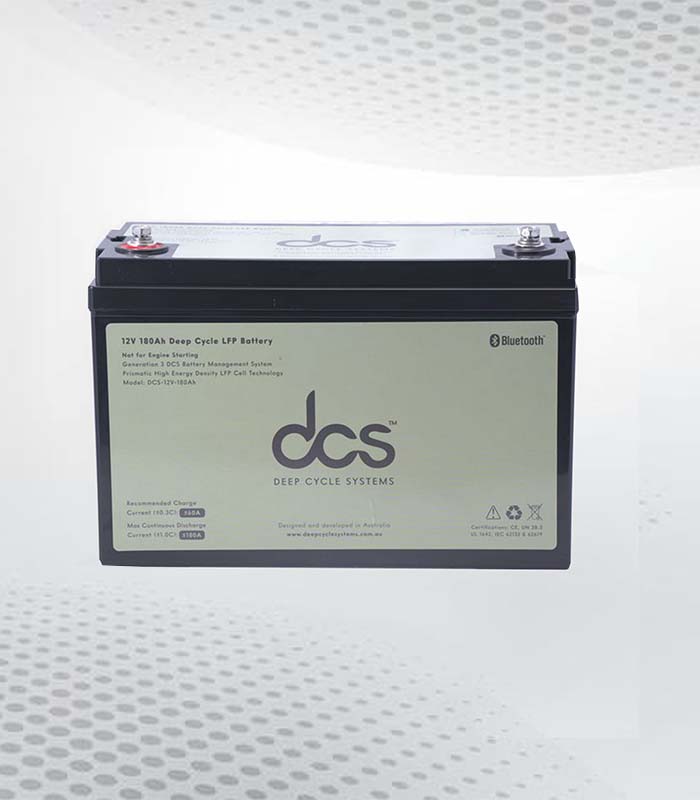When it comes to storing and harnessing energy, the 180ah battery is a powerhouse. With its impressive capacity and voltage, this type of battery is a popular choice for a wide range of applications. This journey into understanding the intricacies of this battery highlights its significance in fostering reliable energy storage options, marking it as an essential element in the broader context of energy management and sustainability efforts.
This blog post will explore the ins and outs of the 180-ah 12V battery, including its technical specifications, diverse applications, charging and maintenance tips, safety precautions, and much more.
What makes the 180-ah 12V Battery Stand Out?
The distinct advantage of the 180-ah 12V battery lies in its remarkable combination of high capacity and optimal voltage, positioning it as a versatile powerhouse for energy storage. Unlike its counterparts, this battery ensures an exceptional energy reserve, capable of delivering sustained power over extended periods.
- This facet is particularly beneficial in scenarios where a consistent energy supply is crucial without the frequent need for recharging.
- Additionally, the 12V specification of this battery renders it compatible with a broad spectrum of devices and systems, from leisure vehicles and boats to solar panels and emergency power backups.
- Its adaptability is further underscored by its robust design, engineered to meet the rigorous demands of both stationary and mobile applications.
- Moreover, the 180-ah 12V battery offers a reasonable balance between performance and cost-effectiveness, distinguishing it from other energy storage solutions that might compromise capacity or affordability.
This blend of features amplifies its appeal across diverse uses and underscores its role in driving efficiency and reliability in energy storage and management solutions.
The Technical Specifications Explained
Delving into the technicalities of the 180-ah 12V battery, it’s essential to grasp what the figures represent. The capacity denoted as 180 ampere-hours (Ah), signifies the electric charge the battery can hold. It can supply 180 amps of current for an hour under ideal conditions. Alternatively, this could mean 18 amps for 10 hours, showcasing its ability to provide a steady stream of power over time.
The voltage, marked as 12V, refers to the electrical potential difference the battery can provide, aligning it with numerous devices and systems that operate on a 12V basis. This voltage is pivotal for ensuring the battery can seamlessly integrate into various setups without requiring complex conversions.
Understanding these specifications is paramount when selecting a battery, as they directly influence its battery’s and performance in specific applications. Whether for a leisure vehicle, solar power storage, or any other system requiring reliable energy, these metrics offer a clear insight into the battery’s capabilities.
A Comparison with Other Battery 180Types
The Battery 180 is a noteworthy contender in the energy storage landscape, offering a unique blend of advantages when measured against alternative battery types. Delving into comparisons, lead-acid batteries emerge as an initial point of reference, primarily due to their widespread adoption and cost-efficiency.
However, these batteries typically fall short in energy density and longevity, factors where the 180-ah 12V variety tends to excel. On the other side of the spectrum lies the lithium-ion battery, celebrated for its high energy density and longer lifespan. While these attributes are compelling, the cost implication of lithium-ion technology can be prohibitive for certain users, thus highlighting the cost-benefit balance presented by the 180-ah 12V battery.
Nickel-cadmium (NiCd) and nickel-metal hydride (NiMH) batteries also share the stage in specific applications, each with their strengths and weaknesses. NiCd batteries, for instance, are known for their robust performance in extreme temperatures and quick charging capabilities. Yet, they are overshadowed by environmental concerns and the “memory ef,” etc.” NiMH ba” series offers a more environmentally friendly solution with a higher capacity than NiCd batteries but face challenges with self-discharge rates and sensitivity to overcharging.
By juxtaposing these different battery technologies, it becomes evident that the 180-ah 12V battery provides a middle ground, balancing performance, cost, and versatility. Its suitability across various applications underscores its adaptability, affirming its status as a reliable choice amidst the complex landscape of battery options.
Diverse Applications of the 180-ah 12V Battery
The versatility of the 180-ah 12V battery extends to many practical uses, underscoring its adaptability in various fields. In recreational vehicles (RVs) and marine vessels, this battery emerges as an indispensable component, providing the necessary power for lighting, appliances, and auxiliary systems, thus ensuring comfort and convenience during extended journeys. Its significant capacity and reliable voltage make it an ideal choice for renewable energy storage, particularly in solar power setups.
Here, it excels in accumulating surplus energy during peak sunlight hours, which can then be utilized during periods of low light or at night, facilitating a consistent energy supply. Furthermore, off-grid locations benefit immensely from deploying 180-ah 12V batteries, which serve as the backbone for backup power systems, guaranteeing energy availability in areas devoid of conventional electricity sources.
This battery also finds applications in electric vehicles, contributing to the propulsion system’s high energy density and endurance. Each application demonstrates the battery’s battery’s role in supporting sustainable and autonomous energy solutions across diverse sectors.
180ah 12v: Charging and Maintenance Tips for Longevity
Adhering to judicious charging and regular upkeep practices is paramount to maintaining optimal performance and extending the lifespan of a 180ah 12v. Charging the battery following the manufacturer’s specifications and employing a charger suited for that specific need is paramount.
An intelligent charger that prevents overcharging by switching off once the battery is fully charged can be particularly beneficial. Equally important is avoiding the depletion of the battery below 50% of its capacity, as deep discharging can significantly impair its lifespan.
Periodic inspections should be part of the maintenance routine, focusing on the terminals and connections to ensure they remain clean, tight, and corrosion-free. A mixture of bicarbonate of soda and water can effectively neutralize any corrosive build-up. Furthermore, it’s advisit to keep the battery in a ventilated, temperate environment, steering clear of extreme temperatures, which can hasten degradation.
Engaging in these practices preserves the battery battery maximizes its efficiency and reliability over time. Regular maintenance checks and appropriate charging habits are instrumental in safeguarding the battery against premature wear and ensuring its longevity.
Safety Precautions and Best Practices
Adhering to safety protocols while handling a 180-ah 12V battery is critical to prevent accidents or injuries. Donating protective clothing, including gloves and safety goggles, is essential to shield against potential acid spills or sparks during installation or maintenance. The storage location for the battery must be carefully selected; a well-ventilated area devoid of direct sunlight and extreme temperatures helps mitigate the risks of overheating or freezing, which can compromise the battery’s performance.
The battery should also be placed away from combustible materials to minimize fire risk. It’s also Vital to ensure that the battery is not subjected to physical damage or shock, as this can lead to internal short circuits or leakage of corrosive substances.
Making secure and correct connections is paramount to avoid short circuits or overloading, which can lead to hazardous situations when connecting the battery to a device or charging it. Regular checks for signs of wear, corrosion on terminals, or swelling of the battery case should be conducted to preemptively address potential safety concerns. Observing these safety practices ensures the user’s and the battery’s optimal functioning and longevity.
The Future of 180-ah 12V Batteries in Energy Solutions
The trajectory of 180-ah 12V batteries is set towards enhancing the eco-efficiency and scalability of energy systems globally. Innovations in material science and battery technology promise to amplify these batteries’ durability and energy density, making them even more integral to sustainable power solutions.
As renewable energy sources, such as solar and wind, become increasingly prevalent, the need for robust, reliable storage solutions grows. The 180-ah 12V battery is poised to meet this demand, offering a green alternative that complements the cyclic nature of renewable energy generation.
Furthermore, advancements in smart technology are expected to introduce intelligent charging capabilities and enhanced diagnostics, improving both the performance and monitoring of these batteries.
Such progress ensures that the 180-ah 12V battery remains at the forefront of energy storage technology, playing a pivotal role in the shift towards more sustainable, efficient, and reliable energy systems. The evolving landscape of global energy demands calls for innovative solutions, and the 180-ah 12V battery is set to be a cornerstone in this dynamic environment.
Navigating the Market: Choosing the Right 180-ah 12V Battery
Selecting the ideal 180-ah 12V battery requires carefully assessing several key considerations beyond capacity and voltage. Quality and reliability are paramount; hence, it is advisable to opt for batteries manufactured by reputable brands.
These manufacturers invest significantly in research and development, ensuring their batteries delivers performance and durability. The brand’s warranty terms and customer support services can also indicate the product’s products and the company’s offerings.
Price, while an important factor, should not be the sole criterion. A lower-priced option might seem attractive initially but could entail higher overall costs if it offers a shorter lifespan or requires frequent replacements.
Therefore, it’s wise to evaluate the total cost of ownership, considering both the purchase price and the expected operational life of the battery.
Lastly, specific requirements for your application should guide your decision. Assess whether the battery’s functions align with your device’s or system’s demands, including compatibility with existing setups and the necessity for additional equipment.
Engaging with user reviews and consulting with industry experts can also provide practical insights into how different models perform under real-world conditions, helping you make a well-informed choice.
Conclusion
Exploring the 180ah 12 V battery has revealed its remarkable capabilities and diverse applications, presenting it as a vital component in the current energy storage landscape. Emphasizing the importance of correct usage, maintenance, and adherence to safety measures ensures that individuals can harness the full potential of these batteries. With technological advancements on the horizon, these batteries are expected to evolve, offering enhanced performance and playing a crucial role in the progression toward sustainable energy solutions.
FAQs
How long should I expect a 180ah 12 V battery to last under normal conditions?
The durability of a 180ah 12 V battery varies significantly based on how it is utilized, its charging regimen, and the level of upkeep it receives. Typically, with diligent maintenance and optimal charging practices, such batteries range from three to five years. Ensuring the battery is not regularly discharged beyond 50% of its capacity and is kept at appropriate temperatures can further enhance its longevity.
Is it feasible to link 180-ah 12V batteries in series or parallel to adjust the system’s overall volt system’s capacity?
Indeed, 180-ah 12V batteries can be configured either in series to increase the overall voltage of the system or in parallel to augment the system’s total capacitsystem imperative; however, to adhere strictly to the recommendations provided by the battery manufacturer when setting up these configurations to avoid any potential safety hazards or operational issues. Ensuring that all batteries in the system are of similar age and condition can also contribute to the overall efficiency and safety of the setup.
What indicators suggest it might be time to consider replacing my 180-ah 12V battery?
Observing signs such as diminished capacity, a noticeable decline in performance, or visible damage and wear to the battery are clear indicators that replacement may be necessary. Should the battery struggle with holding a charge or exhibit swelling or leakage, these are further signs that a new battery is required to maintain optimal performance levels in your application.




